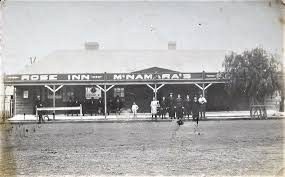Origin of Name
Merriwa is a Wiradjuri word which is thought to mean ‘grass seeds’ or ‘flour made from grass seeds’. The area was initially known as the Gummum Plains district, after the river, which was then known as Gummum Creek.
A History of Merriwa
On the 14th March 1839, John and J M Blaxland, extensive land owners at Gummum Plains Country of Brisbane, approached the Colonial Secretary on behalf of local settlers and asked that the village reserve at that place be thrown open to purchase.
A design for a village at Gummum Plains on the east of and fronting Gummum Plains Creek was drawn up by Assistant Surveyor J F Rusden and received the Governor’s approval under the name Merriwa. (Merriwa is an Aboriginal name meaning “place where wheat is ground” or “rich place producing much seed”).
It was duly notified in the Government gazette of 22nd January 1840. Price was $8 per acre. The first land sales of town lots were held on the 10th and 15th October 1840.
Note – No reference can be traced in official records to the name of Gummum Plains. No doubt it is a corruption of Gummum Plains which latter appears on various old official maps and plans dating from at least as early as 1834. Subsequent to 1839 the creek previously known as “Gummum Creek” appears on plans as Merriwa or Smith’s Creek or Rivulet.
The First Pioneer white settlers are believed to have come to the Merriwa district in the late 1820’s. Messrs. J Blaxland, J Bettington, G Hall, A McKenzie and H Dutton were amongst the early settlers who came in search of good grazing land.
Generally, new settlers occupied the more fertile lands along the various watercourses. The earliest buildings were simple slab huts, so it is doubtful if any still remain. Of the more substantial buildings which followed, the sandstone wing of “Terragong” homestead would be, from all indications, the oldest remaining homestead in the district.
John Oxley passed through the district in 1817.
The first church was built in 1850; the first school (private) in 1849; state 1850; the hospital in 1883; the railway line came to Merriwa in 1917 and electricity in 1937.
Major floods registered in the district occurred in March, 1893; July 1920; February 1950 and February 1955.
The Merriwa Shire Council was inaugurated in 1906 and a meeting of the provisional council was convened on the 6th March 1906. The first poll to elect a permanent council was conducted on the 24th November 1906. The Merriwa Shire Council was amalgamated with the Scone Shire Council in 2004 to become part of the present Upper Hunter Shire.
The following Aboriginal names have been used – Wappinguy means “Big Hall” and Gungal means “Children”.
Mt Oxley is the highestpoint, being approximately 3,300 feet. Merriwa River is the nearest, beginning at the Liverpool Ranges and flowing into the Goulburn River. Its waters are used to irrigate river flats. There is a “National Bridge” over the Merriwa River at Merriwa.
1846 – There were 10 houses in the village.
1848 – An Inn was erected.
1851 – It was stated that the township of Merriwa was rapidly rising in importance. During the previous 15 months, 20 new houses and an Anglican Church had been erected. The church, a slab building was consecrated by the Bishop on the 19th March 1855.
1855 – A Roman Catholic Church was being erected. A new court house was completed in November 1858 and the church, referred to above finished about the same time.
1858 – There were three respectable inns, five stores, two blacksmiths, a few bush carpenters and also tailors and shoemakers. The remainder of the inhabitants were predominantly carriers who chose the town as their home on account of the excellent pastures it afforded their cattle while spelling.
1866 – Merriwa had a population of 200. The new Roman Catholic Church named St Anne’s was opened by Bishop Terregganni on the 13th June 1881.
1884 – The first hospital was opened, Mrs Paul being the first Matron.
1885 – Cobb & Co coaches began running between Muswellbrook and Mudgee passing through Merriwa.
1891 – The population was 437.
1907 – The first Shire Council was established.
1917 – The rail link with Muswellbrook was completed. It is evident that the rabbit population was then large as the canning of rabbits for export was carried out at freezing works.
1933 – The population was about 1000.
1936 – The town was supplied with electricity by M Campbell & Co.
1958 – The town population was 1500.
1990 – The Merriwa Festival of the Fleeces commenced.
2004 – An Object of Historical Importance:
Prior to 1840 grants of land had been made to WC Wentworth (Galla Gilla) and Gregory Blaxland (Cullingral) in recognition of their part of the crossing of the Blue Mountains.
An object of local history interest in connection with these two noted men is the sundial on the pathway at the entrance to the Central School, Merriwa. The sundial was once used by Blaxland in his garden at “Cullingral” while the obelisk on which it is mounted is made from the ruins of “Galla Gilla”.
The Chant of Jimmy Blacksmith
In 1972 the novelist Thomas Keneally took the story of Jimmy Governor and turned it into the fictional, although closely following the story of Governor, The Chant of Jimmy Blacksmith. It was a tragic tale of a young Aborigine who was rejected and racially abused because he had the audacity to marry a white woman. The story of Governor, who lived from 1875 until his execution on 18 January 1901, is intimately tied up with events in the Merriwa district.
Governor worked as an Aboriginal tracker and lived behind the Police Station in Cassilis. He was married to Ethel Page. They had a child and Ethel was pregnant with a second child when Governor, outraged at the treatment he received from the Mawbey family, sought violent revenge.
Governor was contracted by the Mawbeys to build a fence. Contemporary records show that Governor was hard working. He wanted to succeed in white society. Initially Governor was on good terms with his employers but things took an ugly turn when Governor’s wife, who worked in the Mawbey house, was belittled for marrying an Aborigine by Mrs Mawbey and Helena Kerz, the local schoolteacher who was living with the Mawbeys.
Furious at the humiliation, Jimmy and Jacky Underwood on 20 July, 1900 confronted the women. Jimmy claimed that Mrs Mawbey called him “black rubbish” and told him that he should be shot for marrying a white woman. No one will ever know the precise details. What is known is that Governor and Underwood were so incensed they murdered Sarah Mawbey, three of her daughters and Helena Kurz with clubs and a tomahawk. In the melee Sarah Mawbey’s sister was badly injured.
Jimmy, his brother Joe, and Jacky Underwood then went on a three-month, 3,200 km rampage, during which they murdered five more people, wounded another five, committed seven armed hold-ups and robbed 33 homes.
At Poggy Station near Merriwa the Governor brothers, killed Elizabeth O’Brien and her baby son. They hid out in what is now Goulburn River National Park where armed parties conducted a search.
A massive manhunt involving hundreds of policemen and trackers and 2,000 volunteers failed to capture the men who ridiculed their pursuers by advertising their whereabouts and sending satiric letters to the police.
By October, 1900 a £1000 reward for their capture had been posted and later that same month they were outlawed, meaning they could be shot on sight. By the end of October Jacky Underwood had been captured; Joe Governor had been shot and killed near Singleton; and Jimmy was eventually captured by a group of farmers near Wingham two weeks after being shot in the mouth. Jimmy and Jacky were hung in January, 1901. In his last days Jimmy sang native songs, read the Bible and blamed his wife.




